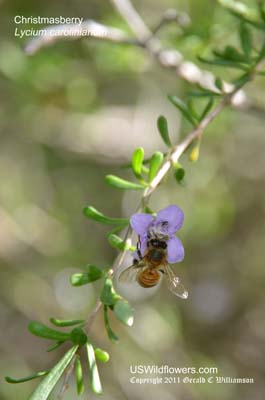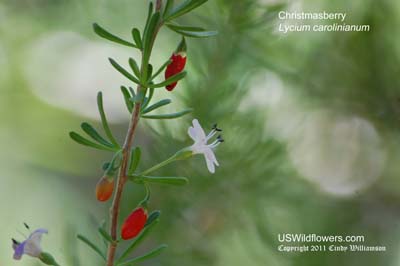Christmasberry, Carolina Wolfberry, Carolina Desert-thorn, Creeping Wolfberry - Lycium carolinianum
|
Lycium carolinianum - Christmasberry, Carolina Wolfberry, Carolina Desert-thorn, Creeping Wolfberry. There are 22 species of Lycium - Desert-thorn - found in the United States, most of which are southwestern species. Lycium carolinianum is the only native Desert-thorn found east of the Mississippi River.
Lycium carolinianum is a shrub that grows from 6 to 10 feet tall. The branches are sharp-tipped.
Found in:
AL, FL, GA, LA, MS, SC, TX
Leave comments on Lycium carolinianum at this link. | 
Distribution of Lycium carolinianum in the United States and Canada:

Blue=Native; Grey=Introduced
Map from USDA Plants Database:
USDA, NRCS. 2017. The PLANTS Database (http://plants.usda.gov, 08 May 2025). National Plant Data Team, Greensboro, NC 27401-4901 USA.
Search Our Database: Enter any portion of the Scientific, Common Name, or both.
Do a general Google search of the entire site:
#ad
 Follow USWildflowers on Twitter
| | Site: De Soto National Monument, Manatee County, FL Date: 2011-December-21 | Photographer: Cindy Williamson
Nikon D40
| | Christmasberry will have brilliant red berries in late fall and early winter. These photos were taken just a few days before Christmas, explaining the Christmasberry common name for the plant. | | 
| | Site: De Soto National Monument, Manatee County, FL Date: 2011-December-21 | Photographer: Gerald C Williamson | | The blossom has 4 petals which are are white underneath and white, lavender, or blue on top, with purple streaks into the corolla tube. There are 4 stamens with dark anthers and a green-tipped pistil which darkens to brown. The stamens extend beyond both the corolla and the pistil. Bees are apparently among the pollenators. | | Click on the photo for a larger image

| | Site: De Soto National Monument, Manatee County, FL Date: 2011-December-21 | Photographer: Cindy Williamson | | The succulent leaves are leaves are linear to oblong, covering the rambling 6 to 10 foot tall shrub. The shrub can be part of a nearly impenetrable thicket in areas which also host mangroves. | | Click on the photo for a larger image

|
References used for identification and information:
|
|
| |
| #ad
|
|





